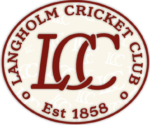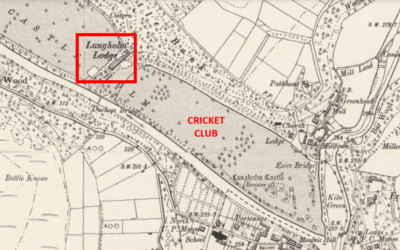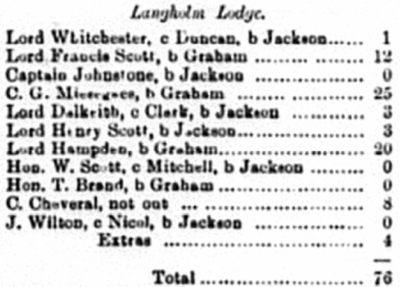
Langholm Cricket Club is a few hundred yards from the site of the former Langholm Lodge, a hunting property owned by the Duke of Buccleuch, which he occupied each summer and/or autumn with his family and guests.

Some of the Duke’s guests played in matches between the Lodge and the Club, and some of the family played regularly for the Club. Like the Rugby Club ground, the Cricket Club’s pitch was on the Duke’s land.
In 1913, the penultimate season before the Great War, the Langolm Cricket Club officials were:
- President: 6th Duke of Buccleuch (died in 1914)
- Vice-presidents: Lord Dalkeith (7th Duke of Buccleuch from 1914), Lord Whitchester, Frederick Berkley Matthews of Westerhall, Richard Graham of Holmwood (elder brother of Fred Graham, below)
- Captain: Fred Graham
- Vice-captain: Rev David Inglis, Chalmers United Free Church
- Secretary and treasurer: W Mitchell
- Committee: J N Duncan, John Fletcher, J Clark, W Elliot, J Hotson
In the same year, Lord Dalkeith was president of Marylebone Cricket Club, the sport’s worldwide authority, while being only one of four vice-presidents of Langholm Cricket Club.
Lord Dalkeith presented two bats to Langholm Cricket Club annually as a prize for those who came top in the season’s batting and bowling averages.
Below is the batting scorecard for Langholm Lodge against Langholm Cricket Club on Tuesday 9th September 1913, the 82nd birthday of the 6th Duke of Buccleuch. It includes two future dukes of Buccleuch. The 6th Duke, who died the following year, watched the match with the Countess of Dalkeith [Molly Scott nee Bridgeman?, future Duchess of Buccleuch], Viscountess Hampden (the 6th Duke’s daughter Katharine, wife of 3rd Viscount Hampden), Lady Margaret Scott and some other family members.

The players listed above are:
- Lord Whitchester: the Duke’s third son, George; first class cricket player.
- Lord Francis Scott: the Duke’s sixth son; see 11th February 1915 in the Diary about his marriage; later a settler in Kenya.
- Captain Johnstone: possibly a member of the Johnstone family of Westerhall.
- Carl Miesegaes: Carl, son of local ‘gentleman farmer’ Ary Miesegaes.
- Lord Dalkeith: the Duke’s second son, John; 7th Duke of Buccleuch from 1914.
- Lord Henry Scott: the Duke’s fourth son; first class cricket player.
- Lord Hampden: the Duke’s son-in-law, Thomas Brand, 3rd Viscount Hampden, married to Katherine Scott.
- Hon W Scott: probably the Duke’s grandson, a son of Lord Dalkeith; either Walter (future 8th Duke of Buccleuch) or William.
- Hon Thomas Brand: the Duke’s grandson, later 4th Viscount Hampden.
- C Cheveral: [not yet identified].
- J Wilson: [not yet identified].
The jacketed captain below in the front row with the dog is Fred Graham, co-owner of woollen mill Reid & Taylor. Behind his left shoulder is John Scott, 7th Duke of Buccleuch. Behind his right shoulder is Rev David Inglis of Chalmers United Free Church, a regular player.

Lord George Scott, younger brother of the 7th Duke of Buccleuch, played first class cricket, including for the Gentlemen (amateurs) against the Players (professionals).

Most first-class matches in cricket-playing nations were cancelled during the Great War. Many club matches continued, but Langholm cancelled all of its play.
Numerous international and first-class players lost their lives in the war. Langholm Cricket Club lost Lieutenant Corporal William Elliot at the Battle of Loos on 29th September 1915, a wool sorter at Buccleuch Mill.
W G Grace died of a stroke in 1915, aged 67: see 23rd October in the Diary.
In the 1914 season, Langholm won only three of its nine matches, although with only eight runs fewer than the opponents in total. Opponents included Upperby, Lockerbie, Hawick and Wilton, Annan, Dumfries and the Cameron Highlanders B Company.
William Jackson, millworker, topped the batting averages and Alex Morrison, blacksmith, the bowling averages (although the E&L later reported that Fred Graham had the highest batting average). The low batting averages compared to today’s typical club figures are indicative of the poor quality batting surfaces of the era, unprotected from the elements and also used, for example, by Langholm for a dance in 1914 prior to a match.
